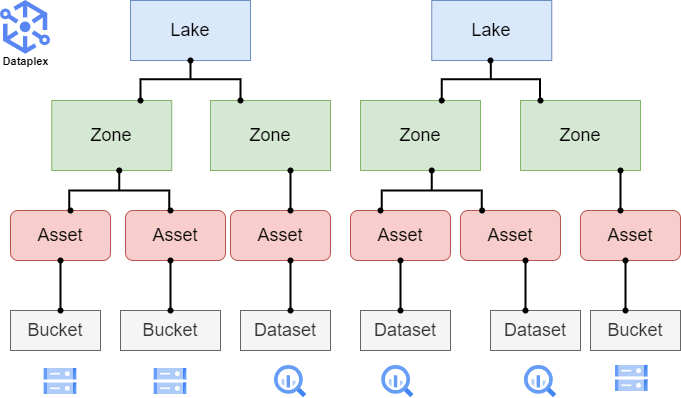Today, enterprises face challenges with managing, accessing, and utilizing vast amounts of data efficiently across multiple silos. The conventional approach often involves making trade-offs, such as duplicating data or limiting its distribution, impacting decision-making capability. However, a promising solution emerges in the form of Google Dataplex, an intelligent data fabric designed to revolutionize how organizations manage and utilize their data resources.
Overview of Dataplex
Google’s Dataplex presents an innovative approach to centrally manage, monitor, and govern data across various repositories, including data lakes, warehouses, and marts. This revolutionary tool promises to securely deliver accessible data to diverse analytics and data science tools. Leveraging a combination of Google Cloud and open-source technologies, Dataplex offers a comprehensive analytics experience, empowering users to curate, secure, integrate, and analyze data at scale.
Key Capabilities and Benefits of Dataplex
Data Storage Options: Dataplex allows flexible storage options while enabling users to select the best analytics tools for their specific needs, thereby optimizing performance and cost efficiency
Unified Security and Governance: Enforce consistent controls across diverse data sources, ensuring unified security and governance policies across the entire data landscape.
Data Intelligence through AI/ML: By leveraging Google’s AI/ML capabilities, Dataplex automates data management tasks, elevating data quality and streamlining decision-making processes.
Organizing and Securing Data with Dataplex
Logical Data Constructs
Dataplex introduces logical constructs like lakes, data zones, and assets, providing a structured foundation for organizing data without needing movement or duplication. For instance, creating lakes per department and defining zones based on data readiness and usage enables a more streamlined data organization.
End-to-End Data Security
Dataplex empowers data owners to define and enforce policies seamlessly across data domains, ensuring secure access regardless of data location. It offers granular security not only for data but also for related artifacts such as notebooks and scripts.
Dataplex Components and Use Cases
Discover:
- Explore: The Dataplex Exploration Workbench is similar to Google Cloud Platform’s BigQuery service. It allows for data analysis using standard SQL queries. However, it offers a unique feature by enabling the creation of Notebooks and Spark SQL scripts for data analysis. Additionally, it allows the scheduling of these scripts for exploration purposes.
- Search: In the Search section, users can search for specific data based on a domain. Upon searching the domain, all tables associated with that domain are displayed, regardless of where the data is physically stored. Clicking on a table provides detailed information such as storage location, table schema, data profile, and quality results linked to that table.
Manage Catalog:
Tag templates, entry groups, and glossaries assist in managing metadata and organizing data assets effectively within the catalog.
Manage Lakes:
Within Dataplex, the management section enables users to construct their personalized data mesh. It facilitates data organization by creating lakes, zones, and assets based on specific domains or business units.
Dataplex Data Management Architecture:

Lake: A lake in Dataplex symbolizes a data domain or a distinct business unit. For instance, individual lakes can be established for various departments such as Retail, Sales, Finance, and Production to categorize data according to departmental usage.
Zone: Zones, subdomains within a lake, are created to cater to specific perspectives within a domain. These zones, consisting of both Curated and Raw categories, serve distinct purposes. The Raw zone allows the mapping of raw data, while the Curated zone facilitates the mapping of transformed or curated data.
Assets: Assets, or datasets, are integral components in Dataplex. They enable the mapping of BigQuery datasets and data stored in Cloud Storage Buckets. Moreover, Dataplex allows data mapping from separate Google Cloud projects as assets into a single zone for convenient access and management.
Entities:
Entities in Dataplex represent metadata for structured and semi-structured data. After mapping datasets within a zone, all the tables and information that these datasets hold can be visualized and managed within the Entities section.
- Secure: The Secure feature serves as a centralized access control policy tool within Dataplex. It empowers users to manage permissions for creating lakes, Zones, and assets, and accessing data associated with a lake via mapped assets (such as Google Cloud resources like Cloud Storage buckets and BigQuery datasets). This functionality enables users to assign specific roles and permissions to control access.
- Process: Orchestration of data pipelines, quality checks, and custom Spark jobs for efficient data curation and processing.
Govern:
Google Cloud Dataplex enhances governance by centralizing data management and providing automated data discovery, classification, and quality monitoring. This streamlines compliance, improves data integrity and facilitates comprehensive data lineage and auditing.
- Profile: The Data Governance Profile within Dataplex offers a comprehensive analysis of your managed data. It allows for configuring and scheduling profile checks across your dataset. With Dataplex, multiple checks can be created and executed concurrently. Post-check runs, the results showcase key metrics such as null percentage, unique values percentage, top 10 values displayed in a bar graph format, and statistical insights including mean, standard deviation, minimum, maximum, and the range of lengths for categorical variables, among other details.
- Quality: Dataplex ensures data reliability through quality rules like NULL, Value-set, Regex, and Uniqueness checks on column data. Rule failures trigger alerts via Cloud Logger in GCP, highlighting issues for immediate attention. Troubleshooting in Dataplex involves running queries to isolate records that breach set rules, aiding in pinpointing and resolving data quality concerns.
Conclusion
Google Dataplex emerges as a transformative force in resolving prevalent enterprise data challenges. Its intelligent data fabric simplifies data unification, management, and access across various repositories. By providing a unified platform with robust governance, security, and analytics capabilities, Dataplex empowers organizations to harness the full potential of their data resources. This unified approach is poised to significantly reduce data management overheads, enhance data quality, and accelerate valuable insights, marking a pivotal shift in enterprise-scale data solutions.




